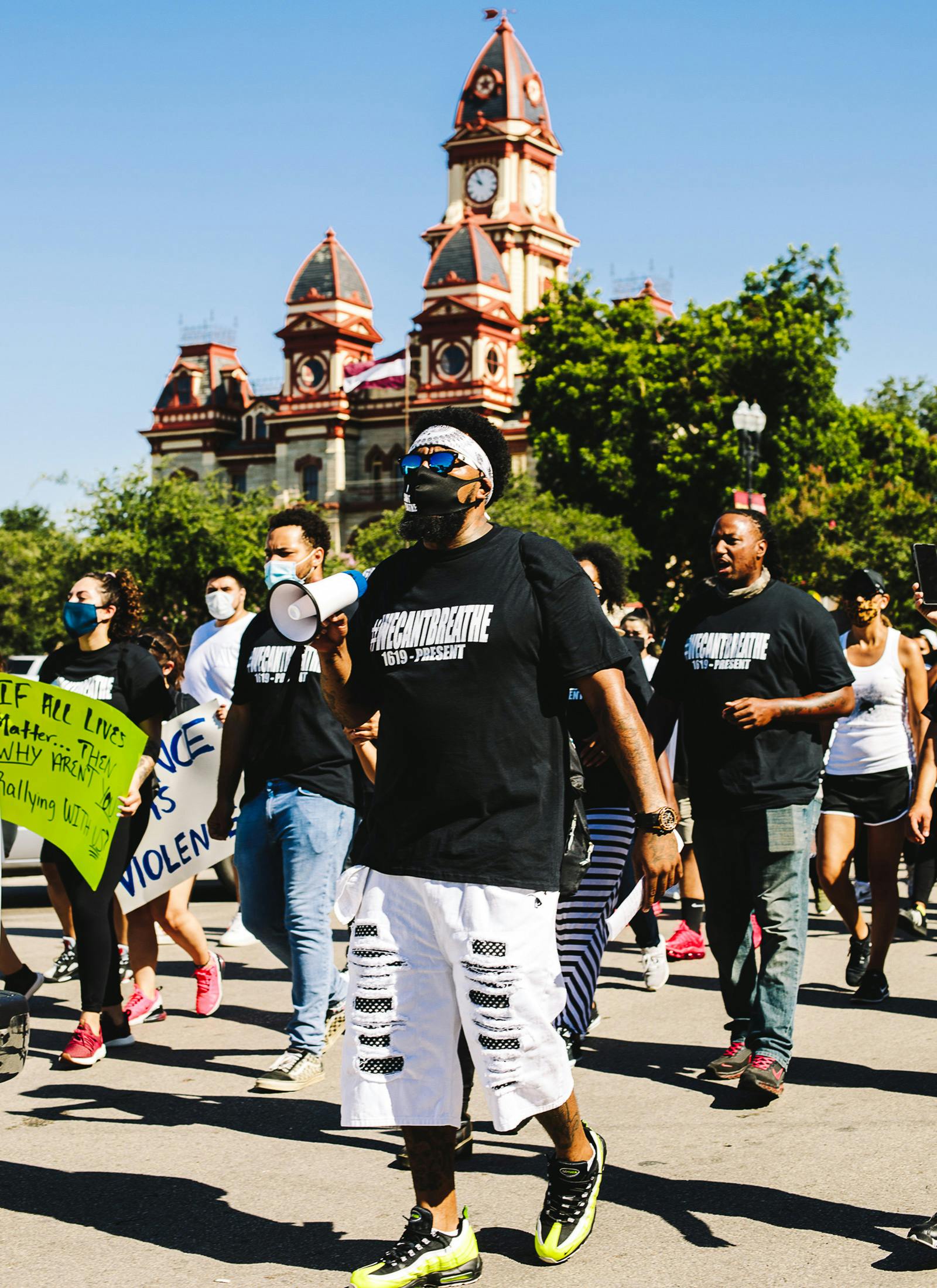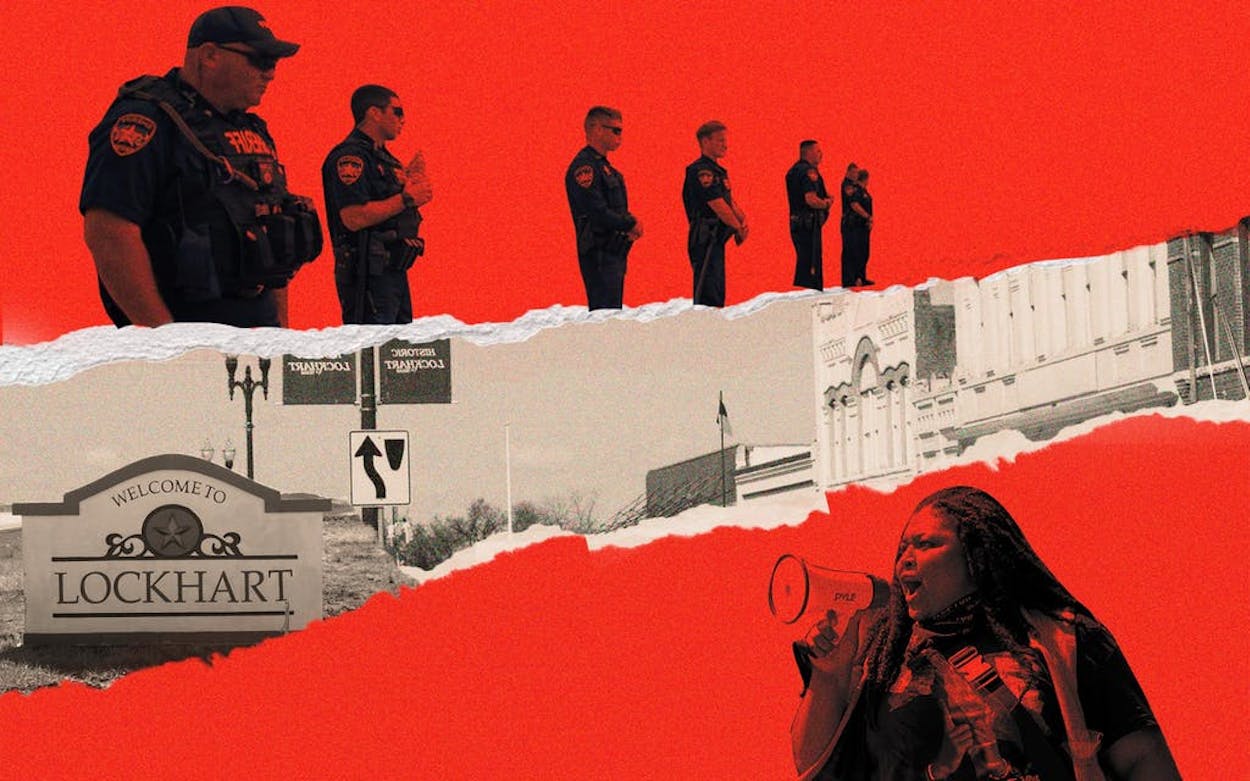When residents of Lockhart, a small town about thirty miles southeast of Austin, discussed holding a civil rights march, Ray Chandler, a deputy constable in surrounding Caldwell County, took to Facebook to post a self-professed “rant.” The one-time Austin police officer and a past executive of the Texas Police Association began with a disclaimer that he believed citizens had a right to protest peacefully. Then, over the course of four paragraphs, he wrote that if his family or property were threatened, he would retaliate. “I will defend myself, my family and my properties,” he wrote, “with a much greater force than what you’re attacking with and I can assure you that you may not live to talk about it!”
The post spurred dozens of similar responses from locals about using deadly force on protesters. One commented, “my best weapon is a 9000lb 4×4 Cummins 6.7 ranch hand bumper up front,” referring to a truck with a powerful engine and oversized bumper. Chandler responded, “well that will definitely do it.” A later comment by the person with the big truck read: “Brother Ray I’m retired I don’t have to be nice to these turds any more let me handle em” [sic]. Others called for an armed counterdemonstration.
Chandler, who did not respond to multiple requests for an interview, subsequently deleted his post, but not before concerned Lockhart residents noticed it. Deputy constables are law enforcement officials, who serve a function similar to that of deputy sheriffs and are appointed by elected constables. To many residents, the exchange about using a truck as a weapon was chilling, given the images of police SUVs driving through protesters in New York City earlier this month. Many also recalled the vehicular homicide of Heather Heyer at an anti-racism march in Charlottesville, Virginia, three years ago this August.
Chandler’s supervisor, Caldwell County constable Tom Will, said in a phone call that he agreed with Chandler’s post. Will said if a protester uses force, “by law, you can use greater force” in return. He noted that the city has “had an MLK [Martin Luther King] parade every year and never had any problems,” and did not expect violence of any sort at the protest. When asked about the possibility that Chandler’s comments could inflame tensions or foster fear among residents, Will said, “Those citizens are the ones that want to do away with the police department, so I don’t care about them. The ones that are crybabyin’ about that are not from Texas.”

Across Texas, tensions between some in law enforcement and protesters organizing marches against police brutality have come to a head. Chandler’s posts came days after a sheriff’s deputy in nearby Bexar County was placed on administrative leave pending an investigation for posting a meme with a caption that advocated killing looters. Some Republican party officials have shared similar rhetoric: Shawn Tully, GOP chair of Red River County, posted an image of a person at the Los Angeles riots in 1992 bleeding in front of a truck, with the caption “This is why you don’t brake for ‘protesters.’” According to Scott Henson, former Police Accountability Project director for the ACLU of Texas, some “officers [are] contributing to a culture of retaliation against protesters.”
In Lockhart, a town best known for its wealth of good barbecue joints, police arrested two people who allegedly threatened protesters prior to Saturday’s march. They were charged with making “terroristic threats.” The threats allegedly involved brandishing a gun at a local liquor store and using a vehicle to assault protesters. It was not immediately clear if the arrestees had a connection to each other.
Citing concerns about armed counterprotesters, local record store owner Kana Harris encouraged a dress code—white shirts and masks—for those attending the protest to clearly delineate their participation and desire for a peaceful event.
The protest ensued as planned. At around 9 a.m. on Saturday, more than three hundred marchers congregated in front of Caldwell County’s historic limestone courthouse, where a nearby Confederate monument had been covered with a shroud. The crowd, mostly locals, was racially diverse and included people of all ages, from teens to seniors. Marchers chanted “No justice, no peace!” and recited the names of slain black Americans such as George Floyd and Breonna Taylor as they marched 1.5 miles to the Caldwell County Justice Center. More than forty police officers were onsite for the march, and police chief Ernest Pedraza marched alongside protesters.
The organizer, Margaret Carter—a black woman, lifelong Lockhart resident, and grandmother to five—called the event a success and said, “young people were able to have their voices heard and demand change.”
As the march proceeded, some trucks sat idled at the corners of Lockhart’s downtown square. Inside one vehicle, men were outfitted in camouflage and wore face coverings. One, Ronnie Dirks, said the men were there to “protect officers” and possessed “the means to do it.”
Police on the scene said the men had no affiliation with the force, and Pedraza cautioned that citizens intervening “would be totally inappropriate.”
The phenomenon of vigilantes seeing themselves as extensions of the law is not new, according to Baylor University professor of communication Samuel Perry. He sees those today who say they would engage in extralegal activity to protect police as following a tradition dating back to lynchings, wherein “law and order” community members policed who could occupy public spaces.
Referring to law enforcement encouraging violence, Chas Moore, founder of the social justice and community education nonprofit Austin Justice Coalition, said that “people in power are always going to find ways to use fear and intimidation to suppress people’s power and voice.”
Some Texas legislators have taken up the cause of protecting citizens who injure protesters with their cars. In 2017, a month before the Charlottesville vehicular homicide, then–state representative Pat Fallon, a Republican from the Dallas area, introduced House bill 250, providing civil protections for citizens who harm protesters who are blocking traffic. Though the bill and similar ones in other states didn’t pass, they “stayed on in the imagination of the right as if they did pass,” said Ari Weil, a University of Chicago terrorism expert who studies vehicle ramming.
March participant Sarah DeShay, whose thrift store is the only black-owned business in Lockhart’s downtown, said Saturday’s march was “peaceful” and “very nice.” But she commented that “a couple of people in cars” around the courthouse were “very intimidating,” a point echoed by white and Asian protesters alike.
Dayna Humbert, a Dell employee who moved to neighboring Luling in 2018 and attended the protest, said armed men and the general threat of violence represent a fear that people of color like her deal with every day in Lockhart. “People of color already feel nervous to go downtown,” she said, noting that many black residents of Lockhart are profiled when shopping in stores. The threats never affected her resolve to attend the protest, which she called “powerful.”
“I’m glad this town is coming together,” Humbert said, adding that she hoped significant change would follow.
The glimpse of unity at Saturday’s march in Lockhart is what march organizer Margaret Carter was hoping for. After the march, protesters participated in a community conversation held at the justice center. Chief Pedraza said the Lockhart police department is trying to lead on issues of use of force. Earlier this year, he said, his department “implemented a policy that made the use of force reporting more stringent.” He now gets notified immediately when any force is used. He added that while he has not known his officers to kneel on someone’s neck, the action that led to George Floyd’s death in Minnesota, he has committed to “put it in writing in our policy that it’s prohibited.”
Humbert remarked that the dialogue was “awesome,” but also cautioned, “we must not stop at the sign of hope. We must continue to work towards dismantling and changing the system that continues to oppress, kill, and discard us.”
- More About:
- Politics & Policy
- Black Lives Matter
- Lockhart






